Post Hype Machine: Revisiting Rob Guillory’s “Farmhand” as it Nears the End of its Second Arc
The comic industry has a short memory, as titles are hyped on the approach to their first issue and often forgotten shortly thereafter. On to the next is the typical mindset, with what’s new often leading the way for readers, comic sites and beyond. But that doesn’t mean your average comic ceases to exist, by any means. There’s plenty of goodness still awaiting in these books even if they stop being talked about quite as often.
Those are the titles I’ll be looking at in a new recurring column here at SKTCHD that I’m calling “Post Hype Machine.” It’s going to examine titles that are beyond their first arc, seeing how they’re sizing up now that we’re further into the meat of the story, with these sort of reviews taking a more holistic look at titles rather than looking at a single issue or even an arc. And this week’s first edition will dig into Rob Guillory, Taylor Wells, Kody Chamberlain and Burt Durand’s Farmhand, a title that started as one thing and is morphing into something a little bit different now that we’re nearing the end of its second arc.
Expectations can be a tricky thing. When you’re known for something in particular, it’s easy to have people compare whatever comes next to what preceded it. And sure, it can help you gain an audience from the start, but it also can lead to disappointment or frustration amongst your followers. It’s a double-edged sword in that regard, as the minuses comes from the same root as the plusses.
That’s what Rob Guillory was facing regardless of what he did after Chew concluded. His long-running Image series with writer John Layman was a big success, and one that he’d carry with him no matter if the next project he tackled was a superhero book, a young readers graphic novel, or another creator-owned project. As someone who had a giant hit – Chew did incredibly well in collected form, especially after they rolled out a couple varieties of hardcovers on top of the basic trade form, and it also did numbers internationally 1 – that doubled as his first project of note, comparisons would be inescapable.
So when his follow-up series – an Image title he’s writing and drawing called Farmhand – was announced, it was unsurprising to see a few of those pop up. While it’s nothing similar from a story standpoint, Farmhand does have tonal similarities, matching the blend of funny and super weird that made Chew such a unique series. It follows Ezekiel Jenkins as he and his family move back to his home of Freetown, Louisiana, a town effectively propped up by Jenkins’ father Jedidiah and his honestly insane business that’s built around the Jedidiah Seed, a creation that allows him to create new human organs and body parts from plant life. It’s a literal Tree of Life, if you will. Zeke and his father have a fractured relationship, and this effort to rebuild their connection is at the core of the story alongside the evolution of the impact of the Seed.
When the first issue arrived, it felt like Guillory knew that Chew comparisons would be impossible to avoid, so he didn’t try to. It leaned a bit heavier on the humor than the rest of the series has, as if Guillory wanted to tell everyone, “Don’t worry! I can be funny without Layman!” And sure enough, he was right. The first issue was excellent, ably introducing the concepts and its key players while hinting at what else could come in the series, and it still felt like the right mix of bizarre and amusing that we knew from Guillory. He wasn’t upsetting the apple cart, which seemed to work for the book.
The best part about that, though, was it was like a classic Muhammad Ali move, as Guillory rope-a-doped us into thinking Farmhand would be one thing when it was really something else entirely. That’s not to say he completely lost what was introduced early on, but its slowly morphed from what we thought it was going to be to something a bit different and deeper.
In short, he used our expectations against us, taking what seemed like another fun, weird book and digging into the inherent oddity of the story to find something refreshing and occasionally shockingly dark within it. Don’t get me wrong: it’s still fun and weird! But it also has this looming, sinister vibe to it that takes the book to a different place. That tone really escalated as the second arc began, with the second page of issue #6 being Guillory’s rather ominous warning that something wicked this way comes, and that Farmhand might not be exactly what we were expecting.
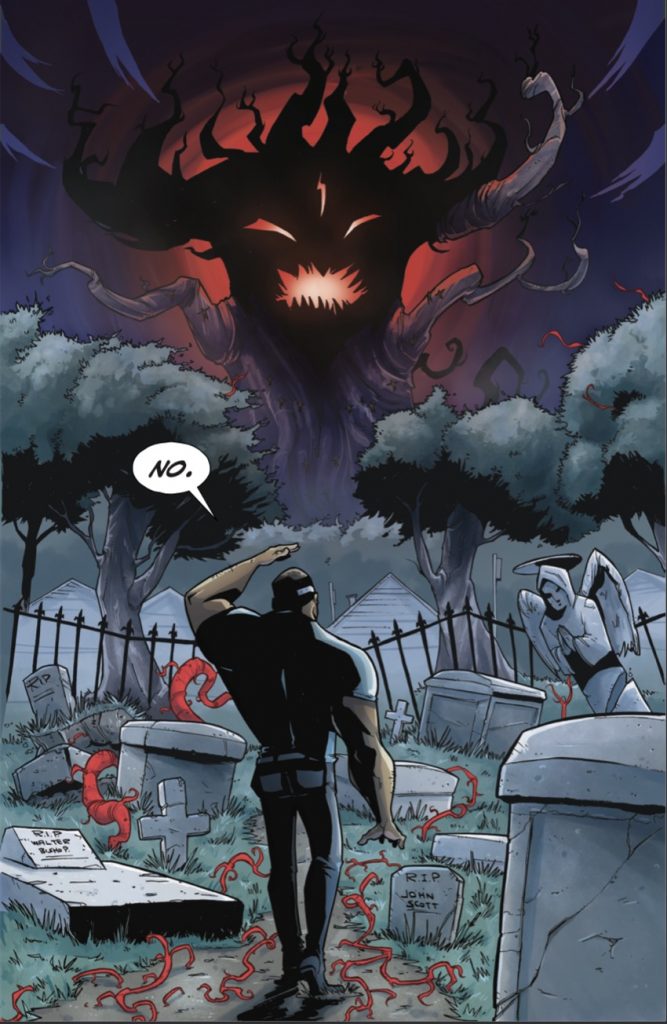
That’s not to say we weren’t getting looks at this before, as issue #5 laid the groundwork for everything that was meant to come in this second arc. But the direction Guillory has taken this book since has shocked even me, which is kind of wild because I was a sounding board for him during the development of this book. I knew the broader direction he planned to go in, but even with that in mind, the depths of the story and its intensity have floored me at times as the world within the book has succumbed to chaos.
It is worth noting that it’s not all supernatural like the above image indicates. While there is plenty of darkness that stems from the Seed’s influence on the world – more on that in a bit – the thing that really makes this book work as well as it does is that even the most bonkers elements stem from basic human relationships.
At its core, Farmhand is about how the past can haunt you and everyone in your life if you let it. The Jenkins family and the extended network of people it has affected – including Jedidiah’s former partner turned town mayor Thorne, his former best friend Tree, 2 Ezekiel’s son’s best friend (but also former Russian spy) Mikhail, and even series MVP/ghost dog thing Gumbo – are facing a whole lot of pain that may have something to do with the Seed Jedediah and Thorne once created, but it has equally as much to do with the scars only time and secrets can give you.
These relationships are complex, and Guillory is always layering in details about the fraught nature of these connections without having to be over the top about it. It’s clever writing, as he ably seeds in lines here and nods there that tell us that there really is something more there. The past looms large in every scene, as every conversation carries the weight of yesterday with it, and it makes the story feel much more lived-in while increasing anticipation because we know something more is coming down the line with the cast.
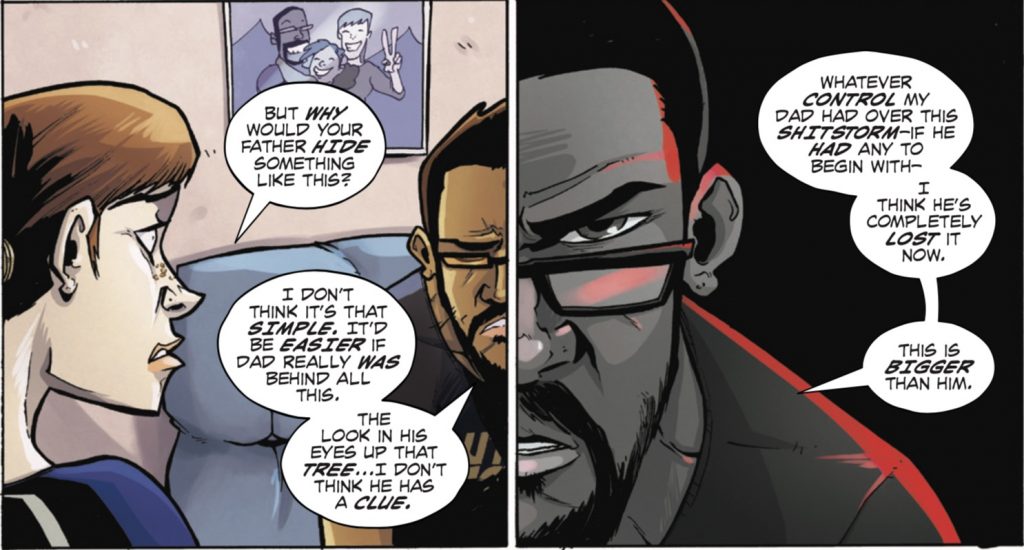
To do al of that, Guillory needed to nail the visual element. For us to feel those relationships and the strain that exists between them, he had to not just tell us, but show us. And the good news is he perfectly underlines the emotionality of the story with his art, using sequences like the one above to build up the intensity and emotion of what Ezekiel is sharing with his wife. As an artist turned writer/artist, Guillory displays an innate understanding of when he needs to pull back and let the art do the talking, or even better, to pull us close to highlight the importance of the moment. That’s something many creators can struggle with early on, but Guillory finds that balance from the jump.
He uses his art as the lead for delivering key information about the cast as well, with two instances standing out in particular. There’s a sequence in issue #2 that helps us better understand where Ezekiel came from and his journey from where he was to where he is when we meet him. 3 And in issue #7, Jedediah confronts a wall of photos of his family, with one particular image – it’s of Tree, Ezekiel and his deceased mother (aka Jedediah’s wife) – that triggers an explosion of emotion from the family patriarch. These two sequences are almost entirely image driven, but in just two rather light on words pages, they speak volumes.
Of course, Guillory also excels at humor, both visually and in his writing. Chew fans will be happy to know there are still plenty of Easter eggs laden throughout the art, but like much of the drama, plenty of the humor comes from relational elements as well. For example, one of my favorite parts of the story is how the aforementioned Mikhail sticks around Freetown and somehow becomes BFFs (literally, that’s said in the comic, I’m not saying that) with Ezekiel’s son Riley. Given that his introduction was as a spy sent by Russia to acquire the Seed for their country, a plan that goes terribly wrong and results with Jedidiah replacing Mikhail’s arm with one from the Jedediah Seed, it naturally leads to a bit of a surprise when the two characters meet again in the sixth issue.
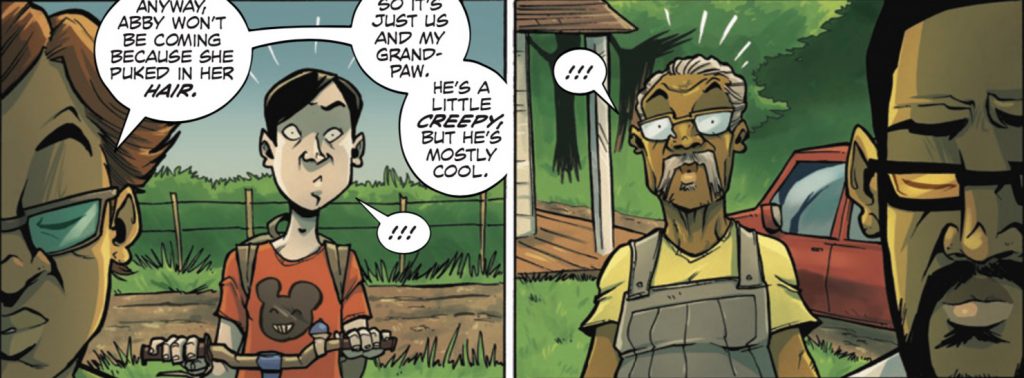
Guillory doesn’t even have to script anything for this moment. It’s just two characters recognizing each other and having the ultimate, “Wait, what are you doing here?!” moment, perfectly depicted with some lines coming off each of their heads to indicate surprise. Simple. Subtle. Highly effective. It’s quality comic booking, and something that made me laugh as soon as I realized what was happening like they did.
And while the relationships between the cast members have been the backbone of everything that has come within the second arc, it’s worth going back to the supernatural elements I mentioned earlier on. This second arc has built up just how deep those roots go, and it’s been remarkable to see how Guillory has built up that side of the world. For one, and I’m not going to go into details here because this is a spoiler-free review, but the villain is genuinely terrifying. There’s a double page spread in issue #9 that haunted me, with the way Guillory depicted it and how Wells colored it giving me as a reader a deep level of uneasiness that I didn’t expect. It’s a heck of a sequence, and one that both works as setup and payoff equally well.
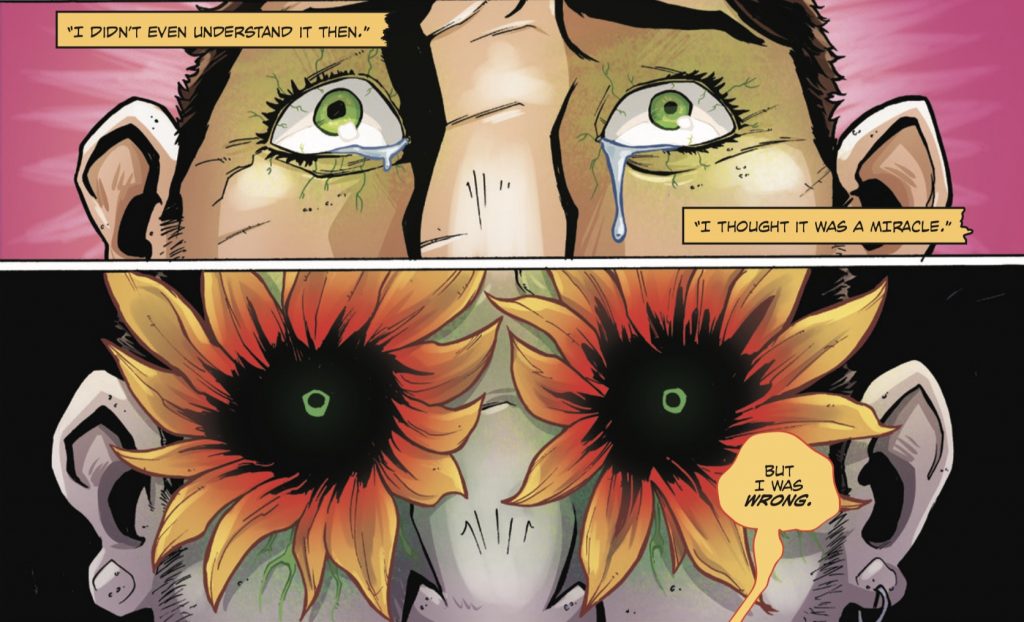
That’s where expectations come in once again. Part of the effectiveness of this book, at least for me, comes from me expecting one thing and Guillory delivering something else entirely. I’m a fan of Guillory and a believer that he could tell whatever kind of story he wanted. But believing he could and seeing it executed are two wildly different things, and I guess I didn’t realize he had this club in his bag. He was the funny guy. The person who made me laugh with random signs throughout Chew. He isn’t a nightmare fuel guy, right? It turns out he is, though.
Despite all of that, this comic is hardly one I’d call oppressively dark. It’s a family dramedy more than anything, with supernatural influences playing an increasingly large part as the drama builds. But, to bring it back to Chew, it reminds me of something Layman once told me, and that was along the lines of “Chew doesn’t have a genre, because it’s about life, and life doesn’t have a genre.” That’s Farmhand too. It isn’t a horror comic, but it has horror elements. It isn’t a comedy, but it is funny. It’s a family story, but as per usual, family is complicated. It’s life, ably realized by one of the best cartoonists around. Sure, it’s a super weird version of real life, featuring some inventive biotechnology and maybe the best dog in comics in Certified Good Boy Gumbo, 4 but it’s life all the same.
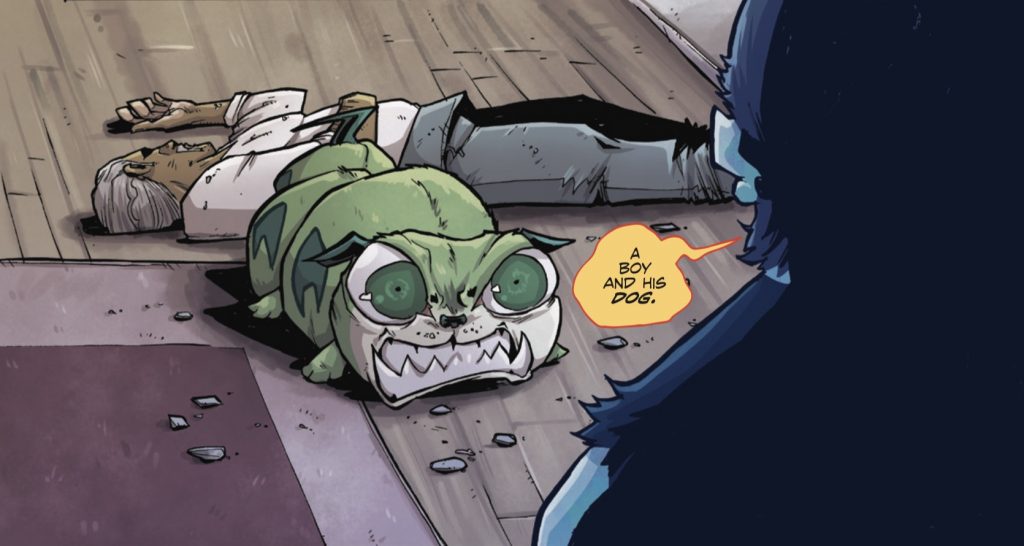
It’s tough for creators on their second big project, and it can be tough for any creator to keep building after a strong first arc in a new story. If Guillory had faltered with this second arc – even a little – I’d have understood. Starting a great comic is tough. Keeping it going can be even harder. Doing it twice? Man, that’s the secret, right?
If that’s the secret, then it’s one Guillory knows because Farmhand’s second arc has taken the foundation built in its first five issues and escalated it completely. More impressively, he did it without losing the heart of the story in the process. Next month’s 10th issue brings the story’s first third to a close – Guillory confirmed to me that the series is set to run 30 issues – and it’s shaping up to be a game changer, as all hell was beginning to break loose at the end if issue #9. I genuinely have no idea what’s coming our way in that issue and beyond. But if Guillory has proven anything over these first ten issues of Farmhand, it’s that we can expect him to deliver the unexpected, and to do it in a way that leaves us always wanting more.
Particularly in France from what I understand, a country where the series was known as Tony Chu: Detective Cannibal.↩
Jedediah has a lot of formers, if I’m being honest.↩
This also features one of the allusions to Guillory’s position in his own story, as Ezekiel is, like Guillory, a comic book artist by trade.↩
He may be the dog equivalent of Janet from The Good Place, though, as I’m not entirely sure he’s a dog of any variety, even if he is roughly dog shaped.↩
